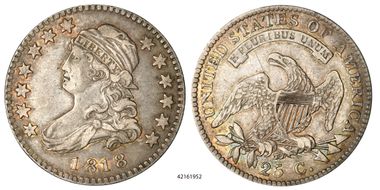sethwinegar 的钱币相册
One variety only. Very much in being the first year in design. Minted eight years after the 1807. The die was designed and engraved by John Reich. He was very skilled and undervalued and left the mint ten years after being hired. Robert Scot was then the engraver from 1818 to 1823, using Reich's original design. Purchased from The Reeded Edge, Inc. March 11, 2011
One variety only. Very much in being the first year in design. Minted eight years after the 1807. The die was designed and engraved by John Reich. He was very skilled and undervalued and left the mint ten years after being hired. Robert Scot was then the engraver from 1818 to 1823, using Reich's original design. Purchased from The Reeded Edge, Inc. March 11, 2011
B-1 R-2 Coin Purchased from Harry Laibstain Rare Coins April 7, 2008. Originally in an NGC holder as a XF45.
B-1 R-2 Coin Purchased from Harry Laibstain Rare Coins April 7, 2008. Originally in an NGC holder as a XF45.
B-2 High R-5 Robert Scot's great skeleton in the closet. Very rare! Only 14 coins certified by PCGS and none by either service in 12,15 or 20. PCGS has only one in XF and none in AU. Browning wrote, "The engraver evidently mistook the die for that of a 50 cent piece, then corrected the error." He actually ended up punching the 5 too low into the dentils.Once he relized he made the mistake he tryed to remove the error as much as possible and then punching the correct numerals to fix it. It is believed through various observations that the die was actually engraved in 1818. Six years later the second chief engraver William Kneass again resurrected the same reverse die in 1828. A possible deliberate act of economy. Walter Breen's comments are that Kneass could blame it on his late predecessor and excuse its exhumation on grounds of economy. This coin was Purchased from Harry Laibstain rare coins, October 30, 2009.
B-2 High R-5 Robert Scot's great skeleton in the closet. Very rare! Only 14 coins certified by PCGS and none by either service in 12,15 or 20. PCGS has only one in XF and none in AU. Browning wrote, "The engraver evidently mistook the die for that of a 50 cent piece, then corrected the error." He actually ended up punching the 5 too low into the dentils.Once he relized he made the mistake he tryed to remove the error as much as possible and then punching the correct numerals to fix it. It is believed through various observations that the die was actually engraved in 1818. Six years later the second chief engraver William Kneass again resurrected the same reverse die in 1828. A possible deliberate act of economy. Walter Breen's comments are that Kneass could blame it on his late predecessor and excuse its exhumation on grounds of economy. This coin was Purchased from Harry Laibstain rare coins, October 30, 2009.
One variety only R-3. Only 24,000 estimated to have been minted of this rare key date. Purchased Oct.14,2008.
One variety only R-3. Only 24,000 estimated to have been minted of this rare key date. Purchased Oct.14,2008.
B-4 R-1 From Harry Laibstain Rare Coins, Purchased December 21,2009. Engraver William Kneass modified John Reich's designs on the then new closed collar quarter.
B-4 R-1 From Harry Laibstain Rare Coins, Purchased December 21,2009. Engraver William Kneass modified John Reich's designs on the then new closed collar quarter.
B-4 R-1 From Harry Laibstain Rare Coins, Purchased December 21,2009. Engraver William Kneass modified John Reich's designs on the then new closed collar quarter.
B-6 R-3 Large Letters variety. Purchased from Harlan J. Berk. Originally in an NGC holder as an AU58.
B-6 R-3 Large Letters variety. Purchased from Harlan J. Berk. Originally in an NGC holder as an AU58.
B-1 R-1 Heritage Auction 4-28-2010. Nicely struck, beautiful dark original coin, with some hidden color.
B-1 R-1 Heritage Auction 4-28-2010. Nicely struck, beautiful dark original coin, with some hidden color.













































